



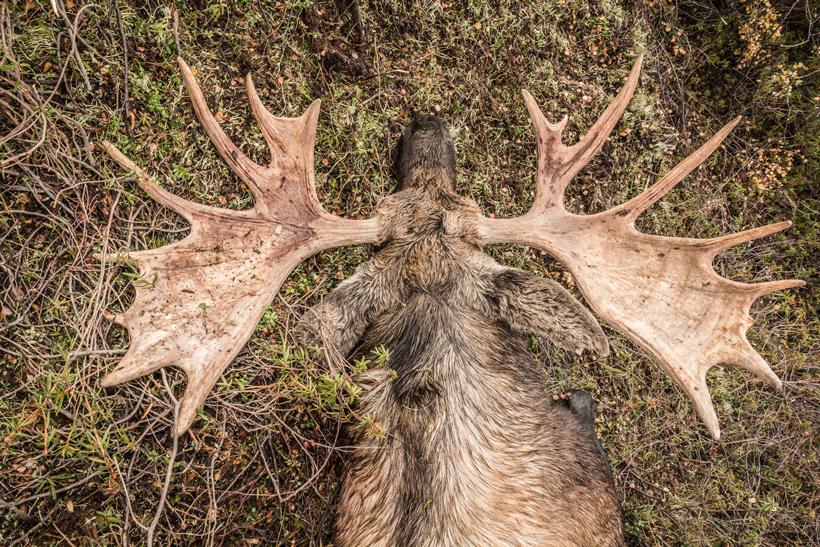
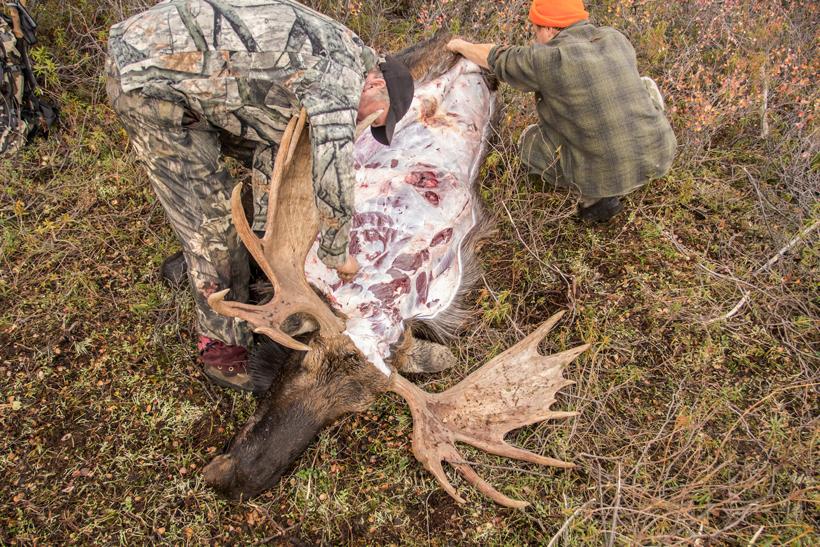
Photo credit: goHUNT.com
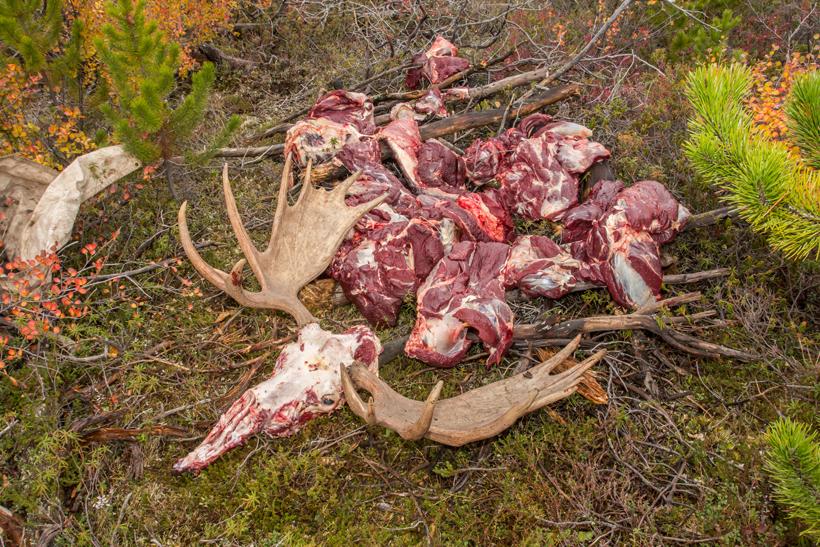
Photo credit: goHUNT.com
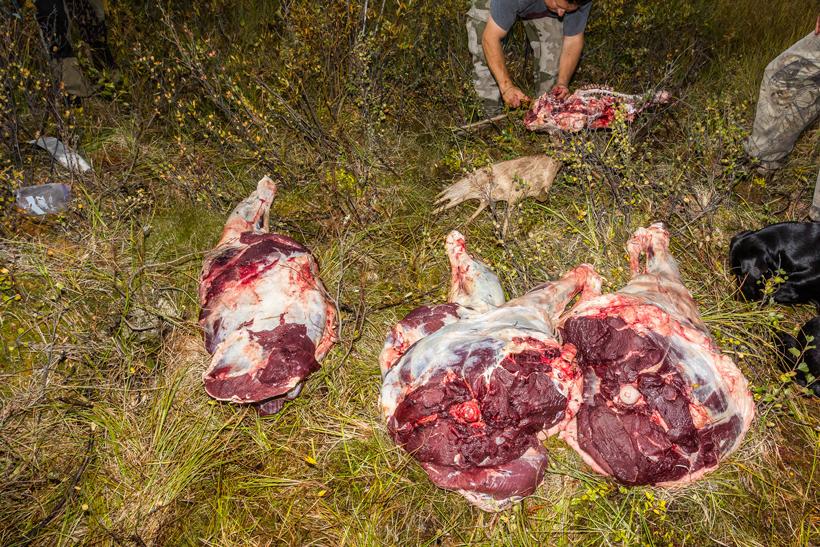
Photo credit: goHUNT.com

Photo credit: Rob Streeter
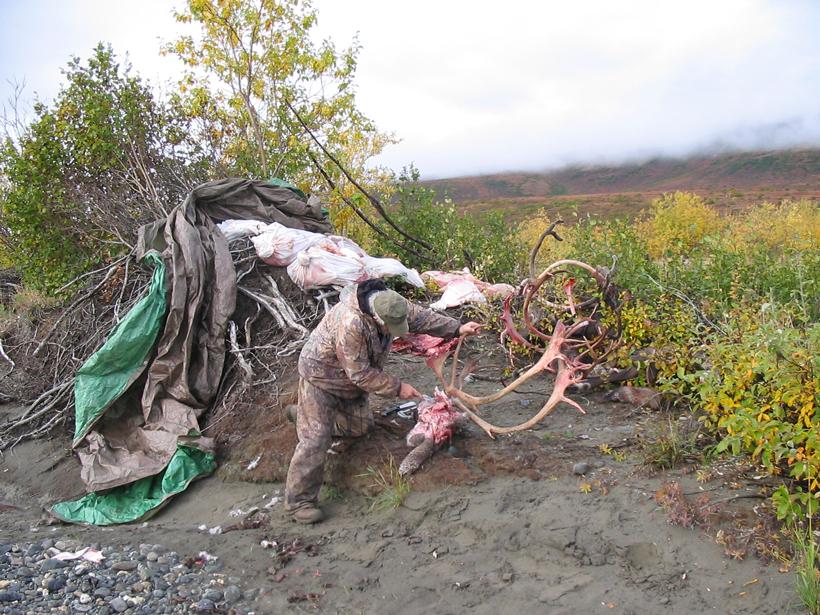
Photo credit: Rob Streeter
As a lifelong deer hunter, I have learned more about meat care on my trips to Alaska than I ever did in the deer woods. When you have an animal down on the first day of a week’s hunt, you really need to know how to handle things.
Harvest a large game animal like a moose, or maybe an elk, and you quickly see the difference from deer hunting. There is no need to field dress a big animal; it is a lot easier to simply quarter it. Find a clean spot to work and have a plan for where you will put the finished meat. (A small tarp comes in handy here.)
We basically skin along the backbone and down along the legs. The next step is to take the back legs off at the hip joint, and then saw the leg bone below the knee. This takes off both hindquarters and gets them ready for transport to camp. We then skin down along the front legs and take them off at the shoulder, and again saw the leg bone just below the knee. With a little practice you can get the quarters off pretty fast. From there, the next step is to take the backstraps off by slicing along the backbone and getting them out in one piece. After that, it is fairly easy to cut all of the neck meat off and reach inside the body cavity and cut out the tenderloins. Then saw off the ribs, and the entire animal is ready to bagged up and packed to camp. This is a handy method for a large animal. Basically, you do side A, then flip it over and do side B.
If it is really hot out and there is a cold stream nearby, the quarters and the rest of the meat can be chilled in the stream, dried off, and then packed out to give it a head start on cooling. This also lets the blood drain from the meat. If you can transport your game by vehicle like we do at home with deer, then simply field dressing it and getting it home is usually preferred. However, for the backcountry, quartering is the best way.
In Alaska, some game management units require keeping the bone in the meat. Obviously, it is lighter to carry without it, but they have found that boned meat clumps together in the game bag and is harder to cool down.
The bones leave some structure to the meat and make it easier to dry the meat out once it is back to camp and hung out for drying. The unit we hunt in Alaska requires this, and we have never had a problem with spoilage, even on hunts with daytime highs near 80 degrees, as it was in one case.
This is something that I have seen work well. Yes, it makes things heavier, but in the long run, having meat that is going to be top-notch table fare is what it is all about.
Not all game bags are created equal. Never use plastic bags of any sort, for instance. The bag has to allow air to move in and out, but not be woven with openings big enough to allow flies in. The current high-tech bags are the T.A.G. bags and Caribou Game bags (made with synthetic material). If you do go for cotton game bags, make sure they are well constructed and skip the cheesecloth bags. You can pre-treat the bags by soaking them in citric acid, allowing them to dry, and then using them. If you skimp on game bags, you will be sorry. If they rip, even just a little, you will be fending off flies
Packing animal quarters in game bags back to camp requires planning and common sense -- and a quality frame pack. I can carry a caribou back to camp in two trips. My buddy Bob Condon has packed out several moose, and that takes more trips because a moose quarter can weigh close to a hundred pounds. Don’t try to pack more than you can handle or you risk injury. Also be careful on the second trip because it is possible that a bear may have taken over the carcass.
Game meat draws flies, and if the little buggers can find any rip, tear, or opening in a game bag, they are going to get into it. This is why good game bags are important. One trick that a lot of hunters use is citric acid, as it discourages the flies and helps preserve the meat. Food-grade citric acid is available at most pharmacies and feed stores. Spray the meat with the citric acid. It will form a dark crust on the outside of the meat that makes it hard for flies to lay eggs on the meat. Once the meat is treated and thoroughly dried, put it back in the game bags.
In camp, if you can hang the meat bags from trees, do so. On the tundra, we grab driftwood and anything else we can get and build a rack to keep the bags up off the ground to let air circulate around them. The meat bags should be covered with a tarp to keep rain or snow off of them, and it also keeps the hot sun off of it as well.
Another great option for meatare meat poles if you are near a frontcountry campsite. Photo credit: GOHUNT.com
Don’t hang the meat and ignore it. Check it each day, and move loose pieces in the bag that contains the backstraps, loins and neck meat. If it sits in a bunch it won’t dry out properly. If you take care, the meat will keep for a week or more in the field — just keep it cool and dry. Remember: flies are drawn to blood. Some hunters actually make fly traps or bring fly paper and hang it near the meat to keep their numbers down. When the weather gets warm, keeping meat in camp and preserving it enough to get it back to civilization is difficult. Make sure you have enough tarps, rope and gear to get the meat up off the ground and keep it safe. It is also a good idea to to have a way to contact your operator or transporter to get out if you score early in your hunt.
If you are lucky enough to bag a big game animal, getting it home to eat it is the last part of the trip -- and it can be the trickiest. Check with the airline and see what their policy is for extra baggage. On my last trip to Texas, I brought a whitetail and a javelina home in a cooler that I bought near the airport. If the meat is cut and wrapped properly, and sealed in a cooler, it is usually cheaper to pay for an extra bag to try and get it home on the flight than it is to pay and ship it. On my Alaska trips, when I get a caribou, there is a lot of meat, so I drop it off at a processor and pay to ship it. One of the reasons we all hunt is for the great table fare that gets us through the winter. If you are heading for a backcountry hunt, it takes planning to turn that game meat you have in the field into great meals at home. Use these tips, and there will be plenty of great meals from your trip!